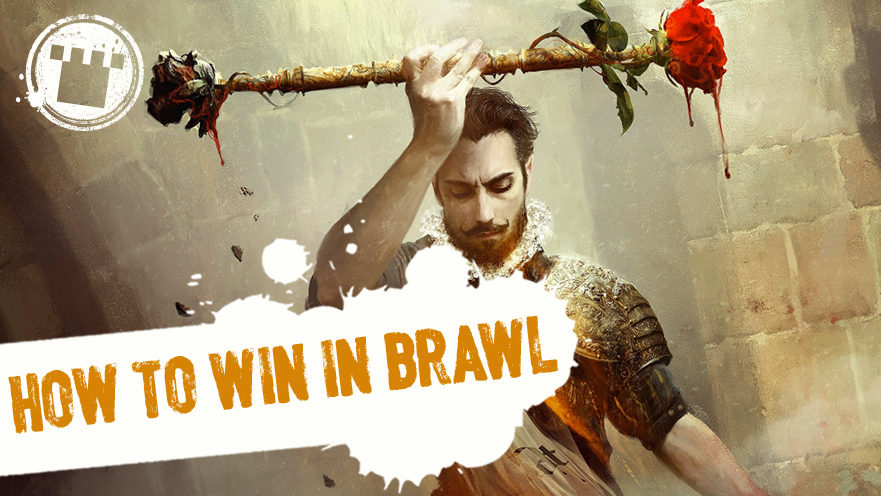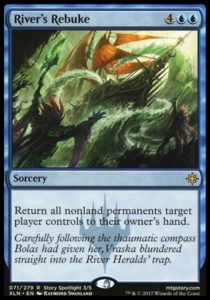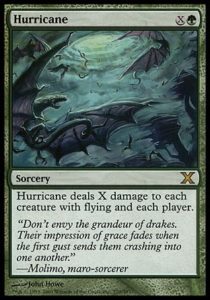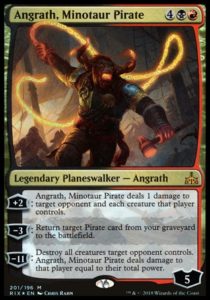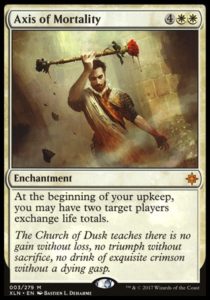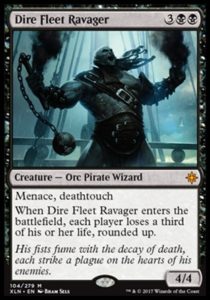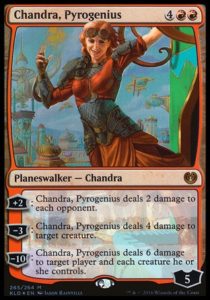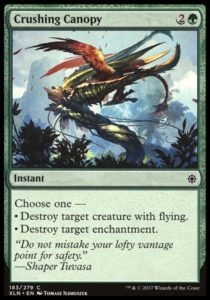Good (your time of day), everyone! I’ve joined the Card Kingdom Blog primarily to discuss multiplayer Brawl and Eternal Brawl, which is Brawl but for any Standard environment in history. I’ve made decks that cover each Standard block, and it’s been a blast to pit two years of the past against the current Standard or have different historical Standard formats face each other. With each deck restricted to two years, the power level is fairly even overall – the more powerful spells of the past are balanced out by newer, more robust creatures – so it works well.
From having built several Brawl and Eternal Brawl decks – I’m up to 15! – and jamming a bunch of games with them, I’ve learned what makes this format tick and the styles of cards that win. Although I’m focusing on multiplayer Brawl for now because that’s how Wizards of the Coast introduced it, a lot of these lessons apply to one-on-one games as well. Long story short, Brawl is a mix of Commander and Sealed, and understanding which parts work together makes for great decks. But why shorten a long story when we can keep a long story long?
When Brawl Stops Being Commander, It Becomes Sealed
If you build a Brawl deck with entirely Commander thinking, it likely will create an unsolvable board stall. This is because two defining features of Commander decks aren’t available in Brawl:
- The stilts. Commander board states are typically built “on stilts,” with mana rocks and ramp in the first few turns enabling much larger plays than other formats. Brawl doesn’t give those options – Sol Ring isn’t available even in Eternal Brawl – so games are lower to the ground. That brings everybody to a gummed-up midgame faster than Commander; not everyone will play artifacts, but everyone will play ground creatures. And solving that midgame is different because of the other defining feature…
- The infinite answers. The stilts dictate the other part of Commander: what do you cast after you empty your hand of ramp? Typically, card draw to find something to do with the mana. And the Blue Sun’s Zeniths and Demonic Tutors of the world allow for at least one answer in the deck for every conceivable board state, from Austere Command‘s flexibility to Cyclonic Rift‘s sweep to Krosan Grip‘s combo-busting.
60-card decks lack room for all that, and Standard formats lack Cyclonic Rift redundancy (to avoid Standard being miserable). In Brawl, you can’t cast River’s Rebuke, draw ten cards, and find two equivalents of River’s Rebuke; you’re more likely to lose from an empty library than anything else.
As a result, you have to save your big removal spells for when it’s absolutely necessary. That’s where Commander influence ends and Sealed influence begins. Opening a River’s Rebuke in your Sealed pool may compel you to play blue, but you can’t just use it whenever you feel like it; you need to craft a board state such that the card can help you win. With only 60 cards, your answers need to be strong and attached to creatures whenever possible; just like in Sealed, maindecking cards like Allay isn’t good against an abstract opponent. In other words, Brawl’s format and deck size constraints prioritize versatility of answers over efficiency of answers, and that’s especially true when those answers can punch through a stalled board.
Brawl is therefore the Hurricane format. Every deck needs cards that punch through ground combat and circumvent the inevitable stalls. You’ll want as many cards like Hurricane and Sleep as you can fit into your Brawl deck.
If you’re considering a Planeswalker for your Commander, prioritize ultimate abilities that punch through. Value engine Planeswalkers like Nissa, Vital Force aren’t as useful as even the intro deck Planeswalkers like Angrath, Minotaur Pirate because none of Nissa‘s abilities deal with or outflank the board state. This may go against everything you’ve learned playing Commander, but the more you play Brawl, the more you’ll start to think like a Sealed player.
Cards You Should Be Playing
To emphasize this point, I’ve singled out a card from each color that, according to EDHREC’s Brawl section, is underplayed relative to the above advice. In Commander, these cards are meh; in Brawl, they do heavy lifting.
Axis of Mortality
I’m now running Axis of Mortality in my Temmet, Vizier of Naktamun deck to help finish off Control decks. It can be a slog to get them into lethal range, as Nicol Bolas, God-Pharaoh decks get Bontu’s Last Reckoning, Sweltering Suns, Hour of Devastation, Star of Extinction, and Baral’s Expertise. And if it isn’t Grixis Control, Sandwurm Convergence provides a different sort of pain.
With Axis of Mortality, you don’t have to keep committing threats; as long as you can shell-game life totals, it only takes one half-threat to take a tough player down. And in multiplayer, other players can aid this goal by attacking you, getting your life total low enough to swap with the much tougher opponent. Willingly go down to 1 life, swap with the Sandwurm Convergence player who’s at 23, and then anyone at the table with a burn spell deals with the big threat. And all it took was resolving one spell that might end up gaining you life.
Curator of Mysteries
Curator of Mysteries is seeing play with The Locust God for its cycling and scry trigger. That makes sense, but the reason Curator is underplayed is because 4/4 flyers for four mana are just plain good in the format. There are only 16 flyers in Brawl with more than four power, so Curator is likely to have somebody to hit consistently. Commander has an infinite scale of creature power that makes 4/4’s look mediocre; Brawl doesn’t have the tools to do that, making a 4/4 more than enough.
It appears that most players are making the mistake of thinking the card’s only good in a cycling-matters deck because that would be correct in Standard or Commander. But this is where the Sealed aspect of Brawl makes Curator of Mysteries a fine inclusion in any blue deck.
Dire Fleet Ravager
The same mistake is being made with Dire Fleet Ravager as with Curator of Mysteries. It’s a Pirate, so it slots most obviously into Pirate decks, but there’s so much more to this card than meets the eye. The enters-the-battlefield trigger is exactly how to move Brawl games along, and menace is more relevant in Brawl than it is in Commander. If I have to have a ground creature, this is one of the best ones available.
Chandra, Pyrogenius/Liberating Combustion
Intro deck products remain mysterious to the general population, as the Planeswalkers in them usually aren’t great for Commander or Standard. But intro deck Planeswalkers have huge loyalty in a format full of board stalls, and their ultimates are designed to win games for otherwise weak decks. Additionally, the decks come with Planeswalker helper cards that tutor (from the library or graveyard) for the built-around Planeswalker and naturally curve into it.
With black and red Planeswalkers, the Planeswalker helpers typically serve as burn or creature destruction, and given that they’re also tutors – albeit severely limited – they’re good deals in Brawl. Liberating Combustion deals enough damage to be always relevant, while Chandra, Pyrogenius‘s plus and ultimate abilities are exactly what you want to end games. Like Hamburger Helper, Planeswalker helpers make a great meal, although both experiences might end in salt.
Crushing Canopy
Since tutoring and card draw are powered down in Brawl compared to Commander, and since a 60-card decklist fills up quickly, dedicated enchantment removal is the hardest thing to include if it isn’t attached to a creature. But there are loads of problematic enchantments in the format, like Sagas, Sandwurm Convergence, Overwhelming Splendor, and Axis of Mortality (if anyone follows my advice). Combining flying and enchantment removal makes Crushing Canopy flexible enough to be worth a slot; every multiplayer Brawl game’s going to have one or the other.
Conclusion
If you’ve played or watched Brawl and thought the Standard card pool doesn’t have enough cards to close out games, your thought is common. Fortunately, it’s mistaken; if you think like a Commander player, you’ll be right, but if you think like a Sealed player, you’ll win games.
I recently played a Brawl game with four Standard commanders (Darigaaz Reincarnated; Rashmi, Eternities Crafter; Hallar, the Firefletcher; and Tiana, Ship’s Caretaker) and an Eternal Brawl Commander (Urza/Masques/6th Volrath the Fallen). By following the principle of playing like a Sealed player, the game advanced crisply and wrapped up in around 90 minutes. I deservedly died first, as Path of Discovery, Tendershoot Dryad, and Slimefoot, the Stowaway made a board so ugly only a River’s Rebuke could (and did) move it. But soon after, thanks in part to Slimefoot drain and Hallar‘s kicking, the Volrath player killed the Hallar and Tiana players on the same turn from a swing of Nightmare at one and Corrupt at the other.
Before I understood how to win Brawl games and adjusted decks accordingly, there was no way a five-player game would have taken 90 minutes. But in that range, it was a fun game where every deck was involved and each player could make big plays. Well-built Brawl decks create a unique experience, and I look forward to exploring the format with all of you.
Header design: Justin Treadway
Header image: “Axis of Mortality” by Bastien L. Deharme

Brandon Isleib plays a lot of Commander and Brawl and loves finding the intersection of unusual and effective plays. He worked for Wizards of the Coast in 2014, he has put flavor text on a few cards, and he’s partly responsible for “create” being the word for cards making tokens. He is a legislation editor for the city of Seattle, he has written a baseball book, and he is proficient at making his bio sound more impressive than it is.

